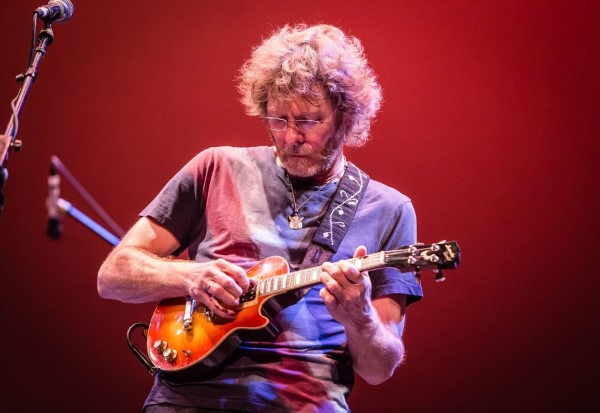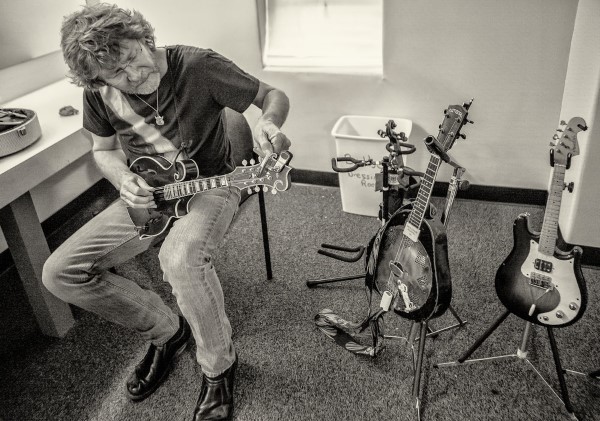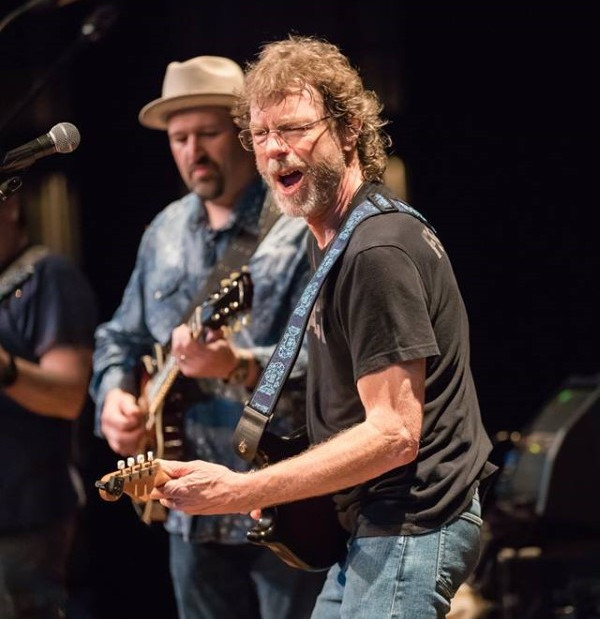
Sam Bush; photo by Shelly Swanger
The average citizen may not recognize his name, but mandolin and fiddle wizard Sam Bush has left a giant-sized fingerprint on the frets of the contemporary acoustic music world. Not only has he officially been named the “Father of Newgrass,” but his hometown, Bowling Green, Kentucky, is now heralded as the birthplace of the progressive acoustic subgenre that twists bluegrass roots around influences as diverse as rock, blues, jazz and reggae. Bush, who co-founded New Grass Revival in 1971, was the band’s main visionary and its beating heart, and the sole remaining original member when the band dissolved in 1989.
New Grass Revival, one of a small handful of genre-bending groups who pointed the way for today’s acoustic jam-band scene, was perhaps the most commercially successful band to harness contemporary sounds to an engine fueled by traditional bluegrass. Not only did the virtuosic quartet influence another whole generation of pickers, but even left a mark on megastar Garth Brooks, who plucked his 1993 hit record “Callin’ Baton Rouge” from the New Grass catalog, enlisting the band to appear as guest musicians on his version.
Bush and his top-flight band will headline Saturday’s double-bill at Nashville’s Marathon Music Works, teaming with The Travelin’ McCourys. The Pulse is giving away a pair of tickets for the 8 p.m. concert. Bush spoke with the Pulse in anticipation of the local show, the first Nashville appearance with his full band since last April’s Earth Day celebration in Centennial Park. Bush, who was sidelined this past summer after an attack of severe abdominal pain at a St. Louis gig required surgery and recuperation time, sounded upbeat and as energetic as ever while discussing his diverse musical background.
PULSE: Looking forward to your show this Saturday, Sam. How often do you get to do dates with The Travelin’ McCourys, and what would you like to say about them for fans of yours who are not as familiar with them?
Sam Bush: Last October, we did five days in a row teaming up with them, and it was so much fun. We love those guys. I’ve known the McCoury brothers [sons of bluegrass staple Del McCoury] since they were in high school. Ronnie and Rob used to come hear New Grass Revival in the late ’80s, so they were teenagers then.
Now of course we’re pals, and pickin’ friends, contemporaries. The musicianship’s terrific onstage. It’s really compatible spirits, because we all come from the world of bluegrass, the progressive bluegrass as well.
And the McCourys, now that they’re The Travelin’ McCourys, they have truly made a new sound for themselves, separate from the Del McCoury Band. They’ve now become their own voice, and the two of us are very compatible. Interestingly enough, it’s the ultimate kind of jam band at the end.
So, both bands play together to close the show?
We do. We don’t have any idea if anyone else is going to show up [chuckles], but we definitely will have both bands together at once. It’s really fun.
What makes bluegrass so flexible, stylistically?
Well, now it is . . . I mean, ’cause I’ve been doing this 50 years. It’s a lot more flexible now than it was 50 years ago, when I got out of high school. It’s hard to believe that when I say that out loud [laughs] but it will be [50 years] this year. It is more flexible because of people like New Grass Revival and the David Grisman Quintet.
We came along after [traditional bluegrass acts] The Osborne Brothers and Jim & Jesse had, you know, gotten airplay in country music and made sounds others could get into while diggin’ the bluegrass instruments. It is much more flexible now. I think we have more people now who are like me when I was a kid. They just like all kinds of music.

So, while it’s flexible, what are the irreducible elements of bluegrass—the things that, no matter how you bend them, are still going to be bluegrass?
Well, one of the first things that come to mind for me is the timing of the music. Bluegrass has its own kind of timing. It’s on the fast side of the beat but we don’t speed up. So I think the timing is the first thing. And of course, the instrumentation—the guitar, banjo, fiddle, mandolin, upright bass and Dobro—signals that to you.
When you hear us and The Travelin’ McCourys, you hear that bluegrass timing, and that’s one of the reasons why we’re so compatible. Even if we’re playing a rock ‘n’ roll song, we all come from a timing that’s very disciplined. Drive and bounce, no matter what tempo you’re playing.
Then you bring in reggae, which cuts the beat in half. To me, that’s the true wild card in your deck, to bring Bob Marley in. How did that all come about?
Well, the Wailers, the first record of theirs that I heard was Natty Dread. What year was that? ’75, maybe? Brand-new, it just came out and it was unlike anything. Bob Marley had already defined his style. And as great as the singing was, and the entire rhythm section and how all that works in reggae, what I mainly noticed was the sound of the rhythm guitar. The back-beat chunk of the rhythm guitar, the chinka-chink-a-chunka-chunk, it reminded me so much of the way bluegrass mandolin players chop rhythm on the backbeat . . . really kinda like Bill Monroe’s mandolin rhythm. Obviously, there was something I could grab on to, because I was already used to playing backbeat rhythm on the mandolin.
So, it was really the sound of Bob Marley’s rhythm guitar that drew me to him more than anything at first. Then I started honing in on the singing and the songwriting and the rhythm section, and how it all worked, and how unique this was. I saw an interview where Bob said [affecting a Jamaican accent], “You can’t be in no hurry to play reggae, mon.”
In 1997, New Grass Revival reunited and backed Garth Brooks on Conan O’Brian. Who put that all together?
Garth [laughs]. Garth did. Two years before that Garth had me come play on some songs for some of his records, and one day he talked to me about recording [Top 40 New Grass Revival country hit] “Calling Baton Rouge.” He said, “I still think that’s a Top 10 record that would start the revival of the last song the Revival had on the radio.” So I said, well, if you do, I know some guys who know the song.
So he cut the track and then he called all four of us, and Jerry Douglas overdubbed on the track of “Calling Baton Rouge.” I played the mandolin and the fiddle, and John [Cowan] and I sang the harmony, Béla [Fleck] on banjo, Pat [Flynn] on guitar, and Jerry on Dobro, and it was really a good day. I don’t know how long after that, Garth assembled us to play the song on a show called VH1 Honors, and then later we went on Conan O’Brian, and played a song Pat wrote, “Do What You Gotta Do.” So that’s how we could get back together, because none of us had [to make] a decision about anything [laughs].
So it was really Garth’s appreciation of the band that was behind it all.
It was. Garth actually . . . a couple of times, we played on the same shows together. Garth had opened the shows for us around [his hometown of] Stillwater, Oklahoma a couple of times, and once he put together a bluegrass band to open for us at a place called Horsethief Canyon. Anyhow, we knew Garth and we had met him way back yonder, and yes, he was always a champion for our band, he was always a fan of our band, and so he wanted us to play with him and we were happy to.

New Grass Revival first toured with legendary pianist and songwriter Leon Russell in 1973, and later was invited by Leon to be his backing band between late 1979 and late 1981. What are your strongest impressions of working with Leon?
Well, I knew at the time that I was working with one of the most masterful musicians I would ever meet. First impression was . . . like, a quick description would be, New Grass Revival as Leon’s backup band was like being in a ’50s rock band with bluegrass instruments. The excitement of some of the shows, it would get running.
There was just a way he would kind of look at us and we’d know he was gonna do it, where at the end of certain songs he would want to go into the speed-up and the rave-up of like, rock shows. But in Leon’s case it was influenced by Pentecostal church services, where it’s goin’ faster and faster, and the hysteria builds, and Leon was a master of that kind of stuff. And he loved it, because without having a trap drum kit, we were really free to go with him at any whim. However fast he wanted to go, we could be with him.
I’ve heard the live version of “Stranger in a Strange Land” you do together, and the energy is entirely different than Leon’s original recording. The collaboration with New Grass seemed to allow Leon to reinvent some of his songs, or the arrangements at least.
Oh, yeah. We were in a rehearsal one day, and, me and [New Grass Revival bassist and vocalist] John Cowan liked to joke around: “How would this song sound if Lester Flatt and Earl Scruggs did it? How would this sound if you made it straight bluegrass? And I was joking when I said, “This is how Lester Flatt would play ‘Jumpin’ Jack Flash.’ And Leon [laughs] said, “I really like that, let’s work it out.” And I said, “No, no, I was kidding. I wanna do the rock version! I want to hear the sound of the piano like you played it at [George Harrison’s 1971 Concert for] Bangladesh! And he’s “nah, I’m tired of that.” And we played that bluegrass/gospel version of “Jumpin’ Jack Flash” for two years [laughs]. And his audience just had a kind of puzzled look on their faces every night we did that. And Leon loved it.
What did New Grass Revival gain from working with Leon?
Well, for me personally, it opened my eyes to more music, things he’d play for me or tell me about. And we literally learned about show business from playing with Leon. And learned about blues, and certain timing, how you could go against the timing . . . because he was masterful. There was always something to learn. As a person who grew up singing bluegrass harmony, that was fun to get to learn more about R&B harmony singing with Leon. And he learned bluegrass from us. We taught him bluegrass songs, and he loved it.
I saw Ringo and the All-Starr Band back in 2000, and lo and behold, you stepped onstage for the encore. How did that happen?
I already had tickets to the show, ’cause when I heard [former Cream bassist] Jack Bruce was gonna play bass, I really wanted to see him. A friend of mine named Terry Cohan was the head of Ticketmaster in Nashville, and [Ringo’s people] had Terry call a few people to see if—it was kind of last-minute—anyone could come out at the end and jam with Ringo. And he called me and I said, “Are you kidding? Absolutely!” So I got to plug my Gibson f5 mandolin into a Vox, what was it, AC30?
Pam Tillis, Kim Carnes and me sat in on the encore, which was “A Little Help From My Friends,” so it was pretty surreal. You know, we didn’t get to meet him before the show or anything, so it was very surreal. We were onstage and Ringo came over and sort of welcomed us personally from the other side of the stage. So it was a wonderful moment, and a life snapshot I never thought I’d get to be in.
On that subject, how have The Beatles touched you musically?
Incredibly. I started playing mandolin in 1963, so when The Beatles first hit, I was pretty young, but my older sisters were buying their records, so I started listening to their records, and then for some reason I bought the record of Rubber Soul and the American pressing has “I’ve Just Seen a Face.” So when that song came on, it sounded kind of like bluegrass, and for the first time I could relate to The Beatles better.
Then when you listen to the whole album of Rubber Soul, that’s when they really went stylistically around the map on that and it was great. Then I really started digging in on what they were doing, and by the time they got to Sergeant Pepper, I had already been exposed to listening to San Francisco bands, specifically Jefferson Airplane, some Grateful Dead, some Quicksilver Messenger Service—but The Beatles, that was the ultimate thing. Sergeant Pepper.
I loved New Grass’s version of “I’m Down.” That’s a raver if there ever was one.
Well, John [Cowan] . . . take a singer like John, because Paul [McCartney] was really screaming “I’m Down.” Like I said, [our version] was John’s bluegrass scream.
Just recently I was down in Florida. My buddy has got a record shop, walked in and—boom, let’s get that Beatles deluxe Abbey Road! So I love all that stuff, I love all the outtakes, I bought all their solo records for the most part, especially George’s, and most of Paul’s, some of John’s, but I especially always loved George’s solo records. So, I’m heavily influenced by ’em.
Would you agree that The Beatles really are kind of the starting point of the idea that country-rock could exist?
Well, I think they’re part of it, not any more than Bob Dylan pluggin’ in, or for instance, early [Rolling] Stones. If you go back and listen to the early Stones, especially the Between the Buttons album, the Stones were country-ish, and it’s odd to think about, because maybe their country-ish came from Buddy Holly or something. Well, what it is, they’re all influenced by The Everly Brothers, so, no, when you think of it, there’s your first marriage of country-rock, The Everly Brothers. Chet Atkins [guitarist and producer on the Everly Brothers’ early Nashville recordings] is right there in on that.
And certainly, Chet and the Everlies were both huge influences on The Beatles, no doubt.
What’s it been like over the past couple decades to watch the full flowering of the acoustic jam-band scene that you had such a hand in stirring up from the beginning?
Well, to me it’s a natural progression of where the music should be going. Some of the young bands dedicate themselves to playing the traditional styles, and then you have others who have always liked what the progressive people were doing. So now that new generation’s come along with their own new ideas of the way progressive bluegrass would go. So that’s been interesting to hear.
One of the greatest things that has been happening in the last 25 years, I’d say, is the emergence of great female bluegrass players and singers. Sierra Hull is a great example. The players, especially, have really progressed. I think that’s pretty important, too. The sound is progressing, and the change that’s going on vocally and instrumentally in bluegrass. So that’s another great thing that’s happening right now. It’s sure fun to be part of it, and to sit back and watch.
Are you seeing bands who aren’t rooted in a bluegrass background but are still contributing, because they come at it from a different angle?
Absolutely. That goes all the way back to when The Grateful Dead did Workingman’s Dead, and Jerry [Garcia] played in Old and in the Way. And so Old and in the Way had a whole bunch of Deadheads coming to their shows who hadn’t heard bluegrass before. In that way, acoustic music and bluegrass in general started infiltrating itself into the jam-band community.
For instance, when Phish played here one time, they invited The Del McCoury Band, me, Ricky Skaggs, and Wynonna Judd to sit in with them. So they had bluegrassers mixin’ in, and still do. The jam bands tend to appreciate the bluegrass musicianship. I mean, I’ve played with moe. before, gone out and played some dates. So, they all kind of go together, really. It’s about communicating, and it does communicate well.
___
Find more on Sam Bush at sambush.com; find tickets to the Jan. 11 show in Nashville at marathonmusicworks.com.













